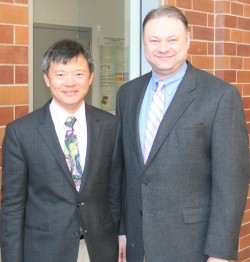
University of Cincinnati Hosts First CADMIM Meeting
The Center for Advanced Design and Manufacturing of Integrated Microfluidics (CADMIM) is a
National Science Foundation Industry/University Cooperative Research Center
. The centers mission is to develop design tools and manufacturing technologies for integrated microfluidics (labs-on-a-chip) targeting cost-effective, quick and easy assessment of the environment, agriculture and human health.
CADMIM builds upon two centers currently in operation, the state-funded Ohio Center for Microfluidic Innovation (OCMI) at the University of Cincinnati (created by the Ohio Third Frontier Wright Projects Program) and the DARPA Microfluidic Fundamental Focus Center (MF3) at University of California, Irvine headed by Abraham Lee. UC's Ian Papautsky, a professor in the College of Engineering & Applied Science, serves as director of OCMI and has been partnering with Lee and UC Irvine for DARPA MF3 since 2006.
The centers first University of Cincinnati led-meeting took place on Sept.11 and 12 in the conference room of the Stratford Heights Pavilion. Opening remarks by CADMIM Center directors Papautsky and Lee set the tone for a relaxed two days of sharing successes and forecasting future plans for the center.
Since the centers open in April of this year, multiple projects have been underway. UC Irvine and the University of Cincinnati are equal contributors in the center's initiatives. The center aims to advance research and education on the engineering, science and applications of integrated microfluidic design and expandable production through dedicated ongoing industrial collaboration.
CADMIM is working to commercialize lab-on-chip technologies, revolutionizing the medical field. Lab-on-chip allows for blood sample readings almost anywhere, and only requires a single drop of blood. This technology gives portability to health assessments and is a more comfortable alternative to patients, given the small sample size.
Papautsky further explains, Our goal is to refine the functions of labs-on-a-chip to create high-capacity, self-contained micro-devices that can be manufactured and deployed in a low-cost but widespread approach. The centers advancements made even in its first year have proven significant in its efforts toward commercialization.
The biannual meetings give industry partners a chance to hear recent developments and research initiatives taking place at the center. Cluing in the supporting organizations shows the companies the clear benefit in partnering with CADMIM.
Some of the centers current projects include:
A Parallel, High Speed Microfluidic Droplet Platform for Multiplexed, High Throughput and Scaled-Up Bimolecular Assays
PI = Abraham P. Lee (UC Irvine), Chong Ahn (U. Cincinnati)
Presenter = Roger Shih (UC Irvine)
The Microfluidics of On-Skin Technologies
PIs = Jason Heikenfeld, Gerald Kasting (U. Cincinnati)
Presenter = Zachary Sonner (U. Cincinnati)
Automated DNA Library Preparation Chip for Next-Generation Sequencing
PI = Elliot Hui (UC Irvine)
Presenter = Brian Luna (UC Irvine)
Integration of Blue-tooth and Power with Flexible, Conformal Motion Sensors
PI = Michelle Khine, Mark Bachman (UC Irvine), Jason Heikenfeld (U. Cincinnati)
Presenter = Jon Pegan (UC Irvine)
The University of Cincinnati and the University of California Irvine look forward to continuing their projects and meeting again back at UC Irvine early next spring.
For more work by CADMIM member Jason Heikenfeld, check out the
latest story on his smartphone sweat sensor
.
Related Stories
OTR mural celebrates UC alumni success
April 4, 2025
The UC Alumni Association, UCAA, will mark its annual Alumni Celebration during its upcoming Alumni Week, April 7-13, with a community art project commemorating this year’s slate of alumni honorees receiving the organization’s top awards.
UC students combine engineering and design experience
April 3, 2025
At the University of Cincinnati, the College of Design, Art, Architecture and Planning hosted a design competition with HAAG-Streit USA, where students were tasked with designing an ophthalmology workstation that is accessible and able to be incorporated into retail settings. Caleb Loayza, a mechanical engineering student at the College of Engineering and Applied Science, and Guy Mueller, an industrial design student, combined their expertise and took home first place.
UC Honors students gain hands-on research experience
April 1, 2025
The Biomedical Research and Mentoring Program is open to any University Honors Program students. The faculty mentors are typically from UC’s College of Medicine or Cincinnati Children's Hospital.
